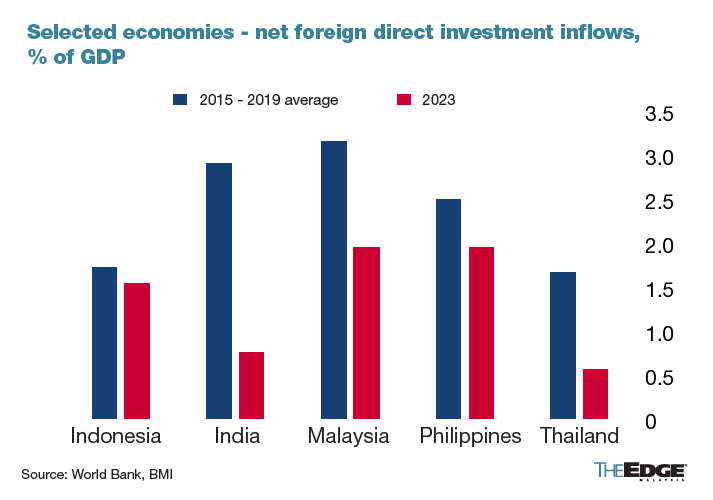BMI raises USD-MYR forecasts to 4.0 this year, 3.55 in 2025, on narrowing yield differentials, resilient growth
KUALA LUMPUR (Sept 27): BMI, a unit of the Fitch group, has revised its year-end forecast for the ringgit from 4.55 against the US dollar to 4.0, reflecting the local currency’s robust performance in the third quarter of 2024 (3Q2024).
"Over the medium term, we continue to hold a positive view on the ringgit, as narrowing yield differentials with the US and a relatively resilient growth outlook bode well for the currency," the research firm said in a note on Friday.
However, risks to BMI's forecasts are skewed towards a weaker ringgit, largely dependent on the US Federal Reserve’s (Fed) interest rate trajectory and mainland China’s growth.
Looking beyond the six-month horizon, BMI forecast the ringgit to strengthen by 9% next year, reaching 3.55 against the greenback by the end of 2025.
The house noted that the ringgit had reversed its broad weakening trend since the start of 2024, gaining 12.1% in 3Q2024, making it the best-performing emerging-market currency in the region.
"To account for the stronger-than-expected performance in 3Q2024, we have revised our forecast for the unit to average 4.35, from 4.55 previously."
The research firm noted that the ringgit touched multi-year trendline resistance at 4.20 on Monday, and sees potential for it to reach 4.0 by the end of 2024, although short-term depreciation is possible due to an oversold relative strength index.
BMI said interest rate differentials between the US and Malaysia are expected to narrow in favour of the ringgit.
The Fed opted for a 50-basis-point (bps) cut this month, taking the funds rate down to 5.0%.
BMI now thinks the Fed will continue with a cutting cycle in the coming months, lowering its policy rate further by a further 75 bps in 4Q2024.
"The narrowing yield differentials will be supportive of the ringgit, particularly if we are right in expecting Bank Negara Malaysia (BNM) to leave its overnight policy rate on hold at 3.0% through end-2024."
Resilient short-term portfolio inflows are also supportive of the ringgit. Cumulative inflows have picked up sharply since July, particularly in debt, and are on track to record their best performance in five years, according to the house.
Beyond six months, BMI expects the ringgit to average 3.80, compared with 4.48 previously, in 2025.
"The primary driver will be further policy loosening worth 125 bps in 2025, which will take the Fed funds rate down to 3.0% by year end," added BMI, which expects the Malaysian central bank to remain on hold at 3.0% through end-2025.
Malaysia’s relatively resilient real gross domestic product (GDP) outlook also supports the ringgit, the house added.
It expects real GDP growth to slow marginally from an anticipated 4.7% in 2024 to 4.6% in 2025. Meanwhile, it projected a more significant slowdown in US growth, lowering its forecast from 2.5% to 1.5% for the same period.
Meanwhile, BMI said the ringgit is likely to benefit from a sustained current account surplus, though it forecast a slight narrowing from 2.6% of GDP in 2024 to 2.4% in 2025.
It said resilient foreign direct investment (FDI) inflows will continue to support the local note. Malaysia has consistently attracted higher net FDI inflows as a share of GDP compared to regional peers like Thailand and Indonesia.
The Malaysian government’s recent announcement of a 0% tax rate for family offices in the planned financial zone of Forest City and reduced income tax rates for foreign workers are expected to boost FDI from 1Q2025.
In summary, the ringgit’s outlook remains strong due to narrowing yield differentials, resilient economic growth, and robust FDI inflows.
However, risks such as the Fed’s interest rate path and mainland China’s economic performance could influence this trajectory.


